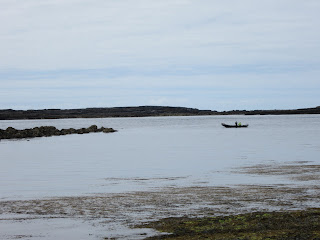I mentioned in my Cliffs of Moher post how I was the only idiot wearing short sleeves. Today, again, I left my jumper in the Hostel. Seriously, what is wrong with me? This is Ireland! I do it like I have something to prove. What, or to whom remains a mystery. Upon arrival at the port for the ferry I saw threatening dark clouds all around me and cursed myself. In this case I happened to have been lucky - the weather fined up magnificently later on. This was also my first ferry of my Europe trip, and I have quite a few left to go. I just hope they're not all as crouded as this one, because most of them will take considerably longer than the 45 minutes it took to get to Inis Mór.
 |
| This is how the whole of Inishmore would have looked before human settlement. |
The bus seats were cramped. I mean cramped. Luckily I had nobody sitting next to me, because the only way I could sit is sideways. But the tour guide was funny and informative, so it was a good tour.
The first thing that struck me was his accent. Inis Mór is one of the few places left that still speaks Irish Gaelic regularly. The island only got electricity (and hence television) in the 1970s, and before that almost nobody spoke English, so Gaelic is still predominant. The guide, whilst understandable, had a very different accent, though still clearly Irish, than I had heard so far. It's hard to explain, but it did sound like the accent of someone who usually speaks another language.
 |
| The fisherman and his son |
The landscape is as such barren. The perforated limestone is like a sieve for water and practically nothing can grow there. And yet, wherever there's a hellish speck of land that only wants to kill you, there's some loony who wants to live there. So people managed to somehow make it farmable. They did so by, first of all, clearing the ground of loose rocks and building low walls for small paddocks. Then they hauled massive amounts of sand and seaweed from the shore to fill in the fields. Then they planted potatoes, because they apparently put up with anything, and after one season they do a pretty good job of turning that muck into workable soil. It seems to have worked too, because there's a lot of green here.
 |
Also interesting were the Seven Churches. Just what they sound like - it's a complex of ruined places of worship with a tumbling graveyard all round. Through a mixture of being as far from invading Vikings as possible and a need to prove their faith almost to the point of masochism, Monks of the medieval period loved building churches and monasaries in the most unlivable and nasty places in the british isles. Hence seven churches. Then Oliver Cromwell came along and spoiled all their fun, but that's another story.

"Then they planted potatoes, because they apparently put up with anything..."
ReplyDeleteDidn't think that potatoes were that bad.